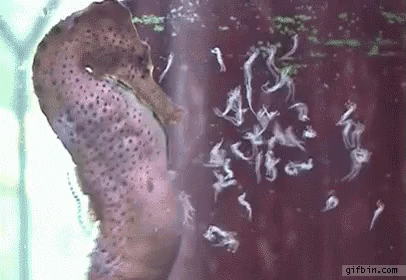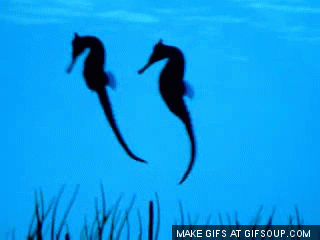
Posted on 08/29/2018 6:24:28 AM PDT by ETL
Seahorses are a group (genus Hippocampus) of small fish belonging to the family Syngnathidae, which also includes pipefish and sea dragons.
These creatures are named for the shape of their head, which looks like the head of a horse.
They are found in shallow tropical and temperate waters throughout the world.
Unlike most other fish, seahorses are monogamous and mate for life.
Pygmy seahorses of the genus Hippocampus are diminutive in size (0.5-1 inch, or 1.36-2.6 cm, long).
They live in close association with octocorals, colonial hydrozoans, bryozoans, seagrass and algae.
They are morphologically distinct from the more numerous and larger species (0.9-14 inches, or 2.4-35 cm) of seahorses in possessing a single rather than paired gill openings and trunk brooding of their young.
Named Hippocampus japapigu, the newly-discovered species measures between 0.55 and 0.62 inches (1.4-1.6 cm) in length.
This pygmy seahorse was found by Dr. Graham Short from the California Academy of Sciences and his colleagues from the Pipefish Stickleback Specialist Group, the Kagoshima University Museum and the Port Stephens Fisheries Institute.
“Hippocampus japapigu is described based on three specimens collected from a mixed soft coral and algae reef at 36 feet (11 m) depth at Hachijo-jima Island, Izu Islands, Japan,” the researchers said.
Hippocampus japapigu occurs throughout subtropical southeast Japan and represents the fifth species of pygmy seahorse recorded in the country’s waters, according to the team.
(Excerpt) Read more at sci-news.com ...

"Hippocampus" comes from the Ancient Greek word hippos (meaning "horse" and kampos, meaning "sea monster".[3]
Having a head and neck suggestive of a horse, seahorses also feature segmented bony armour, an upright posture and a curled prehensile tail.[4]
Habitat:
Seahorses are mainly found in shallow tropical and temperate waters throughout the world, from about 45°S to 45°N [5] and live in sheltered areas such as seagrass beds, estuaries, coral reefs, or mangroves.
Four species are found in Pacific waters from North America to South America. In the Atlantic, H. erectus ranges from Nova Scotia to Uruguay. H. zosterae, known as the dwarf seahorse, is found in the Bahamas.
Colonies have been found in European waters such as the Thames Estuary.[6]
Three species live in the Mediterranean Sea: H. guttulatus (the long-snouted seahorse), H. hippocampus (the short-snouted seahorse), and H. fuscus (the sea pony). These species form territories; males stay within 1 m2 (11 sq ft) of habitat, while females range about one hundred times that.
Description:
Seahorses range in size from 1.5 to 35.5 cm (0.6 to 14.0 in).[7]
They are named for their equine appearance with bent necks and long snouted heads followed by their distinctive trunk and tail. Although they are bony fish, they do not have scales, but rather thin skin stretched over a series of bony plates, which are arranged in rings throughout their bodies.
Each species has a distinct number of rings.[8] The armor of bony plates also protects them against predators, and because of this outer skeleton, they no longer have ribs.[9] Seahorses swim upright, another characteristic not shared by their close pipefish relatives, which swim horizontally. Razorfish are the only other fish that swim vertically.
They swim upright propelling themselves by using the dorsal fin. The pectoral fins located on either side of the head are used for maneuvering. They lack the caudal fin typical of fishes. Their prehensile tail can only be unlocked in the most extreme conditions. They are adept at camouflage with the ability to grow and reabsorb spiny appendages depending on their habitat.[10]
Unusual among fish, a seahorse has a flexible, well-defined neck. It also sports a crown-like spine or horn on its head, termed a "coronet," which is distinct for each species.[citation needed][11]
Seahorses swim very poorly, rapidly fluttering a dorsal fin and using pectoral fins (located behind their eyes) to steer. The slowest-moving fish in the world is H. zosterae (the dwarf seahorse), with a top speed of about 5 ft (1.5 m) per hour.[12]
Since they are poor swimmers, they are most likely to be found resting with their prehensile tails wound around a stationary object. They have long snouts, which they use to suck up food, and their eyes can move independently of each other like those of a chameleon.[13] Evolution and fossil record
Anatomical evidence, supported by molecular, physical, and genetic evidence, demonstrates seahorses are highly modified pipefish. The fossil record of seahorses, however, is very sparse. The best known and best studied fossils are specimens of H. guttulatus (though literature more commonly refers to them under the synonym of H. ramulosus), from the Marecchia River Formation of Rimini Province, Italy, dating back to the Lower Pliocene, about 3 million years ago.
The earliest known seahorse fossils are of two pipefish-like species, H. sarmaticus and H. slovenicus from the coprolitic horizon of Tunjice Hills, a middle Miocene lagerstätte in Slovenia dating back about 13 million years.[14]
Molecular dating finds that pipefish and seahorses diverged during the Late Oligocene. This has led to speculation that seahorses evolved in response to large areas of shallow water, newly created as the result of tectonic events. The shallow water would have allowed the expansion of seagrass habitats that selected for the camouflage offered by the seahorses’ upright posture.[15]
These tectonic changes occurred in the western Pacific Ocean, pointing to an origin there, with molecular data suggesting two later, separate invasions of the Atlantic Ocean.[16] In 2016, a study published in Nature found the seahorse genome to be the most rapidly evolving fish genome studied so far.[17]
The male seahorse is equipped with a pouch on the ventral, or front-facing, side of the tail. When mating, the female seahorse deposits up to 1,500 eggs in the male's pouch. The male carries the eggs for 9 to 45 days until the seahorses emerge fully developed, but very small. The young are then released into the water, and the male often mates again within hours or days during the breeding season.[18] ..."
(snip)
Reproductive roles:
Reproduction is energetically costly to the male. This brings into question why the sexual role reversal even takes place. In an environment where one partner incurs more energy costs than the other, Bateman's principle suggests that the lesser contributor takes the role of the aggressor. Male seahorses are more aggressive and sometimes “fight” for female attention.
According to Amanda Vincent of Project Seahorse, only males tail-wrestle and snap their heads at each other. This discovery prompted further study of energy costs. To estimate the female’s direct contribution, researchers chemically analyzed the energy stored in each egg. To measure the burden on the males, oxygen consumption was used.
By the end of incubation, the male consumed almost 33% more oxygen than before mating. The study concluded that the female's energy expenditure while generating eggs is twice that of males during incubation, confirming the standard hypothesis.[19]
Why the male seahorse (and other members of the Syngnathidae) carries the offspring through gestation is unknown, though some researchers believe it allows for shorter birthing intervals, in turn resulting in more offspring.[27]
Given an unlimited number of ready and willing partners, males have the potential to produce 17% more offspring than females in a breeding season. Also, females have “time-outs” from the reproductive cycle 1.2 times longer than those of males. This seems to be based on mate choice, rather than physiology. When the female’s eggs are ready, she must lay them in a few hours or eject them into the water column. Making eggs is a huge cost to her physically, since they amount to about a third of her body weight.
To protect against losing a clutch, the female demands a long courtship. The daily greetings help to cement the bond between the pair.[28]
Monogamy:
Though seahorses are not known to mate for life, many species form pair bonds that last through at least the breeding season. Some species show a higher level of mate fidelity than others.[29][30] However, many species readily switch mates when the opportunity arises. H. abdominalis and H. breviceps have been shown to breed in groups, showing no continuous mate preference. Many more species' mating habits have not been studied, so it is unknown how many species are actually monogamous, or how long those bonds actually last.[31]
Although monogamy within fish is not common, it does appear to exist for some. In this case, the mate-guarding hypothesis may be an explanation. This hypothesis states, “males remain with a single female because of ecological factors that make male parental care and protection of offspring especially advantageous.”[32]
Because the rates of survival for newborn seahorses are so low, incubation is essential. Though not proven, males could have taken on this role because of the lengthy period the females require to produce their eggs. If males incubate while females prepare the next clutch (amounting to a third of body weight), they can reduce the interval between clutches.[citation needed]
--Wikipedia




Back in the early ‘80’s I worked with a guy who had been a tattoo artist and he had with him a catalog of tattoo art. I thought if I did get a tattoo it would be of a Sea Horse but I decided against it because I didn’t want anyone to get the wrong idea.

A delightful creature! Thanks for sharing.
I wish I had the money and space, I would set up some huge aquariums, marine and fresh water. It’s definitely on my “what I would do if I won the lottery” list.
Wow!
WOWOWOWOW...thanks for posting all the pics, and info. Fantastic little creatures.

You’re welcome. So many incredible things out there to learn about and enjoy.





Disclaimer: Opinions posted on Free Republic are those of the individual posters and do not necessarily represent the opinion of Free Republic or its management. All materials posted herein are protected by copyright law and the exemption for fair use of copyrighted works.